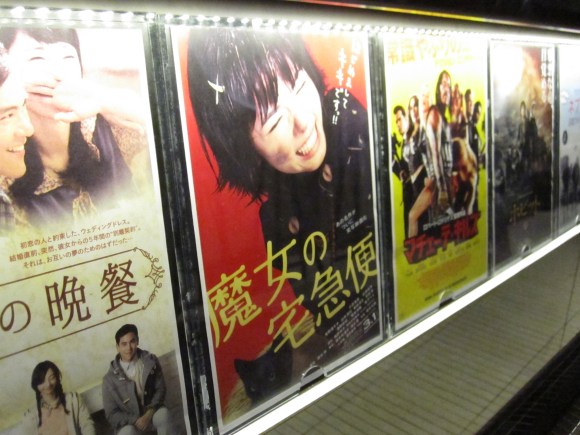
At the same time that director Hayao Miyazaki’s drectorial swan-song, The Wind Rises, opened in wide release in North America, the live-action version of Kiki’s Delivery Service was released in Japan. The coming of age story of a young witch in training is best known internationally for the 1989 Studio Ghibli animated film of the same name, but how does the new version, from production company Toei, compare with the anime classic?
Eager to see if Kiki was better left in two dimensions, we checked the film out for ourselves.
Before diving into the differences between the live-action and animated Kikis, it’s important to note that neither one is the authoritative rendition of the tale of the teenaged enchantress. Both films are adaptations of the novel of the same name, written by Eiko Kadono in 1985. Kadono has since gone on to pen five sequels to her original work, with the most recent published just five years ago.
So what different directions does the new Kiki take? By far the most noticeable is its setting. When trailers for the new film were first released, many overseas fans were troubled about the apparent shift away from the European-influenced locales used for the Ghibli version, and indeed the very first thing viewers of the live-action Kiki see is a line of text explaining that the story takes place in “a town in Asia where people believe in witches.”
Whereas the home village of Ghibli’s Kiki was surrounded by the gently rolling hills that have become a staple of the animation studio’s works, live-action Kiki’s family home is built into the cliffs along a river gorge. The community is occasionally blanketed in snow, and the villagers’ clothes have an almost Tibetan look to them.
Likewise, the town where Kiki lives during her year of solo witch training bears little resemblance to the bustling city seen in the Ghibli version. Instead, it has the relaxed, peaceful feel of a small Japanese fishing port, as could be expected from the new movie’s filming being done on an island in Kagawa Prefecture in Japan’s Inland Sea. It’s been noted that setting of the animated Kiki feels like a kinder, more peaceful version of 1930s Europe, without the political and military turmoil that defined the era in real life. One could say the live-action film does something similar, simply substituting Japan for Europe.
Speaking of Japanese substitutes, the animated Kiki’s ostensibly Caucasian cast is portrayed exclusively by Japanese actors and actresses. This is hardly surprising, considering that the production crew and primary audience are Japanese, as well.
The film does make attempts to strike a sort of nationality-free balance, however. Kiki’s adopted town is still called Koriko, and the names of several people she meets, such as Tombo and Professor In, are right in the grey area of sounding close enough to Japanese to be easy for domestic audiences to remember, while not actually being potentially-alienating, authentically Japanese names. The town’s signage is all in Japanese, and there are citizens who are obviously meant to be Japanese, such as dry cleaner Sumire or schoolgirl Saki, but never once in the film does anyone say the word “Japan.” We never see anyone using chopsticks or eating Japanese food, and there’s even a scene of a little girl clearly wearing shoes inside her home.
“Kiki has to make a choice about whether to continue living as a witch, or live as an ordinary girl”
The basic storyline is similar to the ground covered by Ghibli’s film, with the added wrinkle that after her year of living apart from her family, Kiki has to make a choice about whether to continue living as a witch, or forego her magic powers and live as an ordinary girl instead. This added uncertainty is in keeping with the personality of the live-action Kiki, who we see being more emotional, and at times even confrontational, than her perpetually calm and earnest anime proxy.
As a matter of fact, the live-action Kiki contains quite a bit more conflict than Ghibli’s version. While it never sinks into particularly dark territory, the live-action version, directed by horror movie The Ring’s Takashi Shimizu, keeps its narrative chugging along at a steadier pace than the anime did. Miyazaki’s greater cachet meant that even as he used slow establishing shots to establish atmosphere, audiences could be expected to bear with him, even at times when the plot itself was going nowhere. Shimizu doesn’t have that same luxury, and the live action’s Kiki’s script is heavier on dialogue and issues for the little witch to deal with, such as fellow teen and aviation enthusiast Tombo’s skepticism about magic, the townspeople’s fear of her using her powers to harm them, and the dangers inherent in flying hundreds of feet in the sky astride a flimsy broom.
This different pacing even affects the soundtrack. Compared to Jo Hisaishi’s soothing score for the 1989 version, the new Kiki’s background music is decidedly more up-tempo, right down to the pop/dance anthem “Wake Me Up” by Mai Kuraki, which serves as the film’s closing theme.
“The artist Ursula is nowhere to be found”
Ironically, despite the new Kiki being set in a much smaller town than the anime (likely a budget-based necessity), the live-action version’s residents have more to do with Kiki’s development as a result of her expanded communication with them. The artist Ursula is nowhere to be found in the new film, but we learn more about Tombo’s love of flight and his overall personality. We also hear how bakery owner Osono and her husband met, which leads to a side plot involving a reclusive singer with her own connection to witchcraft.
Speaking of the cast, the film has not one, but two CG animal characters. Although he wasn’t present in the earliest trailers, Kiki’s talking cat companion Jiji is featured prominently, although he’s now played by voice actress Minako Kotobuki, who replaces Rei Sakuma from the 1989 Ghibli version. There’s also a baby hippo named Marco who’s pretty adorable, despite not serving much purpose other than giving Kiki one more challenge to overcome, plus ostensibly to move a little bit of Kiki’s Delivery Service merchandise.
Unlike movies in the U.S., where the hope is that after watching the latest Hollywood hit you’ll head to Target to pick up your Avengers T-shirt or Frozen notebook, in Japan they’ll sell you such things right in the theater lobby.
With Japanese movie tickets already costing 1.800 yen (US$17.50), you could say this is a shameless ploy to squeeze even more money out of theatergoers, but such criticisms are hard to hold onto in the face of such cute stuff as magic broom-shaped pencils…
…special Hello Kitty hand towels…
…Kiki figures…
…a pouch shaped like the little witch’s beloved radio…
…and even child-sized Kiki costumes.
Kiki’s Delivery Service is playing at theaters across Japan. While no subtitles are provided, anyone who’s seen the animated version, remembers what it was like to be 13 years old, or has a touch of magic in their heart should be able to follow the plot without any major problems.
Related: Kiki’s Delivery Service Official Website
Top image: YouTube
Insert images: RocketNews 24, Book Walker, YouTube


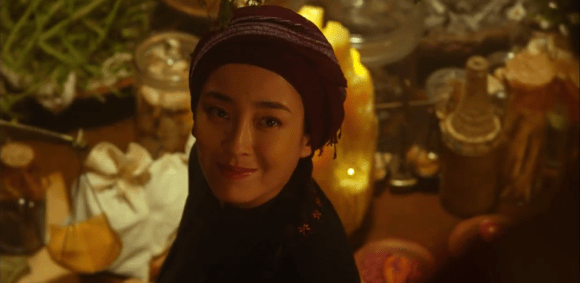
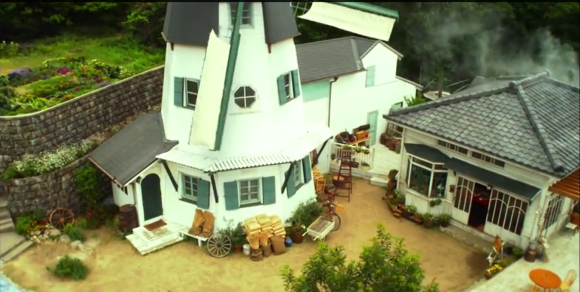
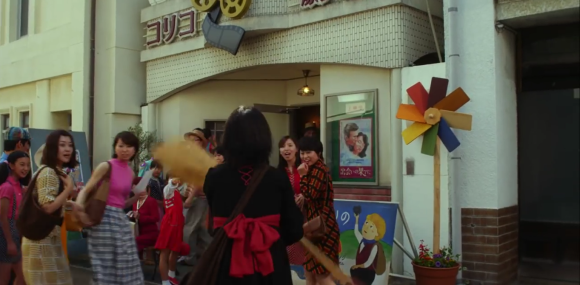
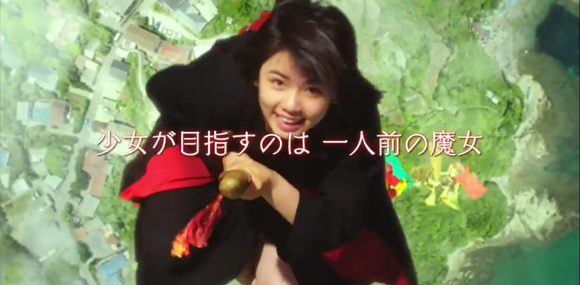
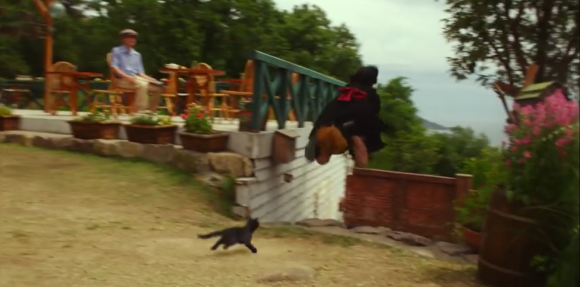
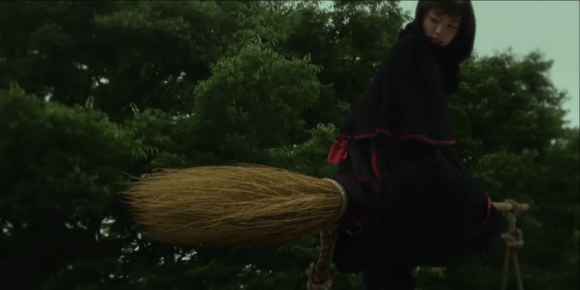
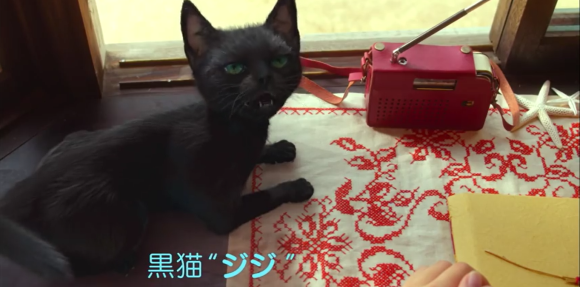
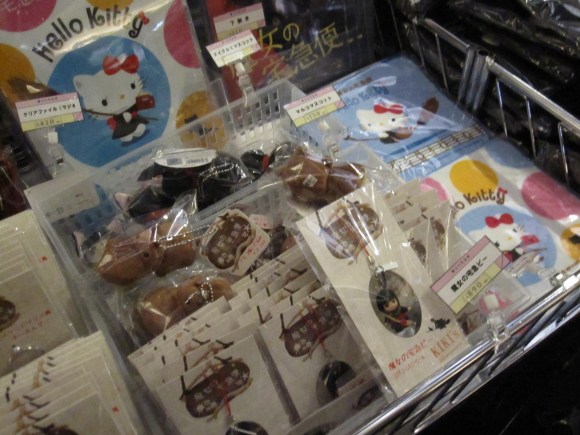
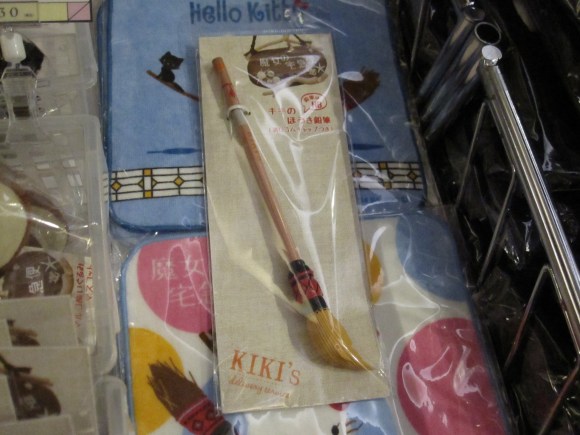
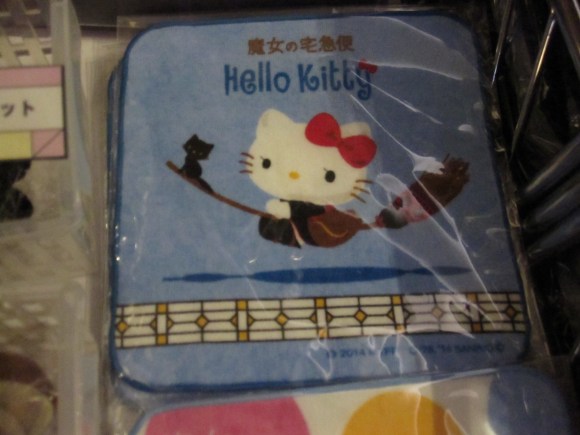
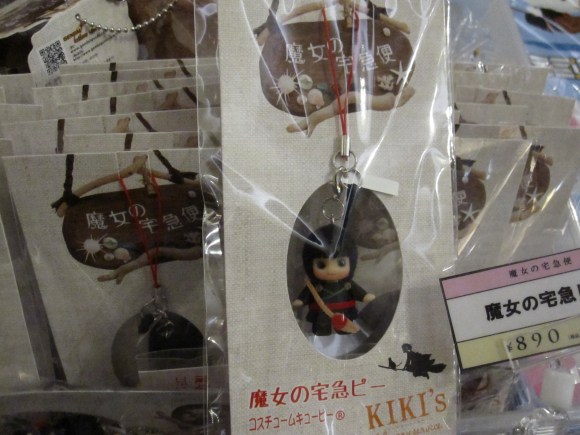

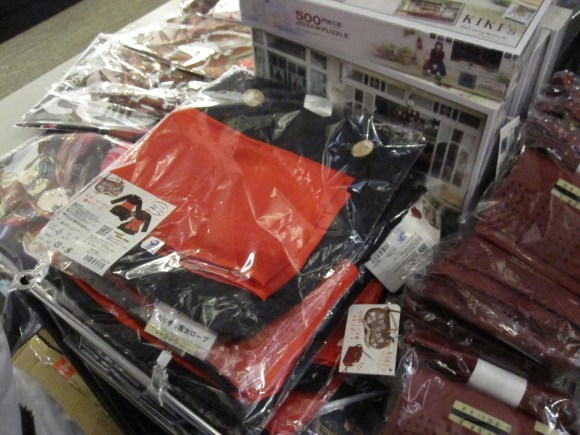
 Japanese men pick their favorite Studio Ghibli anime heroine 【Survey】
Japanese men pick their favorite Studio Ghibli anime heroine 【Survey】 Studio Ghibli releases new batch of Line app anime stamps, this time for Kiki’s Delivery Service!
Studio Ghibli releases new batch of Line app anime stamps, this time for Kiki’s Delivery Service! Tokyo Prince Hotel delivers a hint of magic with Kiki’s Delivery Service suite and bakery
Tokyo Prince Hotel delivers a hint of magic with Kiki’s Delivery Service suite and bakery Traveling with Totoro (and Kiki too)! Official Studio Ghibli suitcases go on sale
Traveling with Totoro (and Kiki too)! Official Studio Ghibli suitcases go on sale Studio Ghibli’s truck from My Neighbour Totoro now available as die-cast Takara Tomy car
Studio Ghibli’s truck from My Neighbour Totoro now available as die-cast Takara Tomy car How to order snacks on a Shinkansen bullet train in Japan
How to order snacks on a Shinkansen bullet train in Japan New Pokémon ice cream, dessert drinks, and cool merch coming to Baskin-Robbins Japan【Pics】
New Pokémon ice cream, dessert drinks, and cool merch coming to Baskin-Robbins Japan【Pics】 Japan’s new difficult-to-drink-from beer glass protects your liver, but it’s a brutal experience
Japan’s new difficult-to-drink-from beer glass protects your liver, but it’s a brutal experience Demon Slayer: Kimetsu no Yaiba gets new roller coaster attractions and food at Universal Studios Japan
Demon Slayer: Kimetsu no Yaiba gets new roller coaster attractions and food at Universal Studios Japan Burger King Japan suddenly adds Dr. Pepper and Dr. Pepper floats to its menu nationwide
Burger King Japan suddenly adds Dr. Pepper and Dr. Pepper floats to its menu nationwide High-fashion Totoro cuddle purse is like an elegant stroll in the forest【Photos】
High-fashion Totoro cuddle purse is like an elegant stroll in the forest【Photos】 Hello, cosmetics! Clinique teams up with Hello Kitty this summer for first-time collaboration
Hello, cosmetics! Clinique teams up with Hello Kitty this summer for first-time collaboration To combat declining birth rate, Japan to begin offering “Breeding Visas” to foreigners
To combat declining birth rate, Japan to begin offering “Breeding Visas” to foreigners Russian crocodile hospitalized after woman falls on it
Russian crocodile hospitalized after woman falls on it Starbucks Japan welcomes alpacas for cute summer drinkware line【Photos】
Starbucks Japan welcomes alpacas for cute summer drinkware line【Photos】 Nintendo history you can feel – Super NES, N64, and GameCube controllers become capsule toys
Nintendo history you can feel – Super NES, N64, and GameCube controllers become capsule toys “The most Delicious Cup Noodle in history” – Japan’s French Cup Noodle wins our heart【Taste test】
“The most Delicious Cup Noodle in history” – Japan’s French Cup Noodle wins our heart【Taste test】 Starbucks releases a cute Frappuccino and Unicorn Cake…but not in Japan
Starbucks releases a cute Frappuccino and Unicorn Cake…but not in Japan Kyoto Tower mascot termination reveals dark side behind cute Japanese characters
Kyoto Tower mascot termination reveals dark side behind cute Japanese characters McDonald’s Japan’s Soft Twist Tower: A phantom ice cream only sold at select branches
McDonald’s Japan’s Soft Twist Tower: A phantom ice cream only sold at select branches Yabai Ramen: What makes this Japanese ramen so dangerous?
Yabai Ramen: What makes this Japanese ramen so dangerous? Finally! Nintendo Japan expands Switch 8-bit controller sales to everybody, Online member or not
Finally! Nintendo Japan expands Switch 8-bit controller sales to everybody, Online member or not Japanese government wants to build luxury resorts in all national parks for foreign tourists
Japanese government wants to build luxury resorts in all national parks for foreign tourists 10 things you should buy at 7-Eleven in Japan
10 things you should buy at 7-Eleven in Japan Studio Ghibli releases anime heroine cosplay dresses that are super comfy to wear
Studio Ghibli releases anime heroine cosplay dresses that are super comfy to wear Woman charged for driving suitcase without a license in Osaka
Woman charged for driving suitcase without a license in Osaka Studio Ghibli unveils My Neighbour Totoro miniature house model
Studio Ghibli unveils My Neighbour Totoro miniature house model Kyoto experiencing problems with foreign tourists not paying for bus fares, but not on purpose
Kyoto experiencing problems with foreign tourists not paying for bus fares, but not on purpose Fighting mild hunger with a Japanese soda that turns into jelly in the stomach【Taste test】
Fighting mild hunger with a Japanese soda that turns into jelly in the stomach【Taste test】 Studio Ghibli’s Howl’s Moving Castle tapestry unveiled in Japan for first time
Studio Ghibli’s Howl’s Moving Castle tapestry unveiled in Japan for first time McDonald’s new Happy Meals offer up cute and practical Sanrio lifestyle goods
McDonald’s new Happy Meals offer up cute and practical Sanrio lifestyle goods Sales of Japan’s most convenient train ticket/shopping payment cards suspended indefinitely
Sales of Japan’s most convenient train ticket/shopping payment cards suspended indefinitely Sold-out Studio Ghibli desktop humidifiers are back so Totoro can help you through the dry season
Sold-out Studio Ghibli desktop humidifiers are back so Totoro can help you through the dry season Japanese government to make first change to romanization spelling rules since the 1950s
Japanese government to make first change to romanization spelling rules since the 1950s Foreigner’s request for help in Tokyo makes us sad for the state of society
Foreigner’s request for help in Tokyo makes us sad for the state of society Ghibli founders Toshio Suzuki and Hayao Miyazaki contribute to Japanese whisky Totoro label design
Ghibli founders Toshio Suzuki and Hayao Miyazaki contribute to Japanese whisky Totoro label design Doraemon found buried at sea as scene from 1993 anime becomes real life【Photos】
Doraemon found buried at sea as scene from 1993 anime becomes real life【Photos】 Tokyo’s most famous Starbucks is closed
Tokyo’s most famous Starbucks is closed Princesses, fruits, and blacksmiths: Study reveals the 30 most unusual family names in Japan
Princesses, fruits, and blacksmiths: Study reveals the 30 most unusual family names in Japan Live-action Kiki’s Delivery Service film’s 2nd trailer previews Jiji
Live-action Kiki’s Delivery Service film’s 2nd trailer previews Jiji Anime fans pick which Ghibli heroine they’d like to have as a girlfriend
Anime fans pick which Ghibli heroine they’d like to have as a girlfriend Live-action Kiki’s Delivery Service film’s new images feature Tonbo, Osono
Live-action Kiki’s Delivery Service film’s new images feature Tonbo, Osono Ghibli cosplay: Official dresses bring anime heroine vibes to your wardrobe
Ghibli cosplay: Official dresses bring anime heroine vibes to your wardrobe Studio Ghibli releases 250 more free-to-download/use images from five films, and Totoro is here!
Studio Ghibli releases 250 more free-to-download/use images from five films, and Totoro is here! McDonald’s Japan now using adorable Kiki’s Delivery Service wrappers for new burgers【Taste test】
McDonald’s Japan now using adorable Kiki’s Delivery Service wrappers for new burgers【Taste test】 Studio Ghibli’s new Kiki’s Delivery Service Tomica makes us rethink toy cars
Studio Ghibli’s new Kiki’s Delivery Service Tomica makes us rethink toy cars New Kiki’s Delivery Service and Howl’s Moving Castle products now available from Donguri Closet
New Kiki’s Delivery Service and Howl’s Moving Castle products now available from Donguri Closet Ghibli Park raises ticket prices, announces Howl area opening date, carousel with ridable Yakul
Ghibli Park raises ticket prices, announces Howl area opening date, carousel with ridable Yakul Studio Ghibli hair accessories keep your style tidy with help from Kiki, Moro, Calcifer, and more
Studio Ghibli hair accessories keep your style tidy with help from Kiki, Moro, Calcifer, and more Studio Ghibli Steam Cream body lotion is this winter’s must-have anime beauty product
Studio Ghibli Steam Cream body lotion is this winter’s must-have anime beauty product New Studio Ghibli gloves will warm your heart and hands this winter
New Studio Ghibli gloves will warm your heart and hands this winter Ghibli Window Wall Art series turns any wall into a portal to an anime wonderland【Photos】
Ghibli Window Wall Art series turns any wall into a portal to an anime wonderland【Photos】 Ghibli theme park will recreate Howl’s castle, Princess Mononoke’s Irontown, and Kiki’s house
Ghibli theme park will recreate Howl’s castle, Princess Mononoke’s Irontown, and Kiki’s house SoraReview: Mary and the Witch’s Flower, the newest anime from Studio Ghibli director Yonebayashi
SoraReview: Mary and the Witch’s Flower, the newest anime from Studio Ghibli director Yonebayashi
Leave a Reply